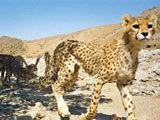Iranian scientists working to save rare cheetah
Iranian scientists working to save rare cheetahAssociated Press

*In this photo released Saturday Sept. 3, 2005, by Environment Protection Organization of Iran, Asiatic cheetahs are seen in this June 10 2005 picture taken by camera traps in Dareh Anjir, in an isolated wildlife refuge in central Iran. (AP Photo)*
TEHRAN, Iran — Wildlife experts are celebrating the sightings of two groups of rare Asiatic cheetahs in central Iran during recent months, raising hopes that one of the world's fastest moving creatures could be saved from extinction, conservation officials said Saturday.
Iranian wildlife scientists saw four adult cheetahs in August, two months after camera traps revealed a female cheetah with her four cubs resting under the shade of a tree, said Houshang Ziaei, an official of the Environment Protection Organization of Iran.
Once ranging from the Red Sea to India, the Asiatic cheetah today are hanging on by only the thinnest of threads. Fewer than 60 exist on the entire Asian continent, mostly on Iran's arid central plateau.
Fewer than 10,000 cheetahs are also believed to be still living in Africa, where protection is questionable and habitat is vanishing.
"The two discoveries of cheetahs are very encouraging," said Ziaei, who is in charge of a project seeking to protect Asiatic cheetahs in Iran, which is being run in conjunction with the United Nations Development Program and the Wildlife Conservation Society.
The four adult cheetahs were seen two weeks ago near Naiband, a village in Iran's central desert, said Ziaei, who is one of the scientists surveying the Naiband cheetahs.
Camera traps set to survey wildlife also photographed an entire family of Asiatic cheetahs in June, including a female and her four youngsters, resting in the shade of a tree in Dareh Anjir, an isolated wildlife refuge in central Iran, said Ziaei.
The two groups of cheetahs are the largest-known of these rare cats ever photographed in Asia, said Ziaei.
Once known as "hunting leopards," cheetahs have played a significant role in Iranian history, being trained by ancient emperors to hunt gazelles.
In the 1970s, estimates of the number of cheetahs in Iran ranged from 100 to 400.
But widespread poaching of cheetahs and their prey during the early years of the 1979 Islamic revolution, along with degradation of habitat due to livestock grazing, have pushed this important predator to the brink of extinction.
Scientists have been surveying five protected areas where cheetahs were still thought to exist. The group found a variety of suitable habitats, but also discovered that prey species, such as jebeer gazelle and urial sheep, were scarce.
Cheetahs usually die before reaching six months mainly due to hunger, but Ziaei said the latest discoveries and photographs hint at the gradual recovery of prey populations.
The sightings have also encouraged Iran's Environment Protection Organization, the UNDP and WCS, which joined forces in 2001 to identify cheetahs and their prey, to extend their three-year project until 2007.
"As a species the cheetah is still in dire straits in Iran, so it is extremely encouraging to see an apparently healthy family in their native habitat," said Dr. Peter Zahler, assistant director for WCS's Asia programs. "Images like these give hope to conservationists that there is still time to save these magnificent animals."
Biodiversity expert Parviz Bakhtiyari said hundreds of volunteers have helped search for cheetahs and prey species and installed camera traps in several wildlife refuge regions in central Iran.
Asiatic cheetahs became extinct throughout much of the Middle East about 100 years ago, although they were spotted in Saudi Arabia until the 1950s. They vanished in India in 1947, while spotty records claim they ranged in Central Asia as far as Kazakhstan from the 1960s through 1980s.



